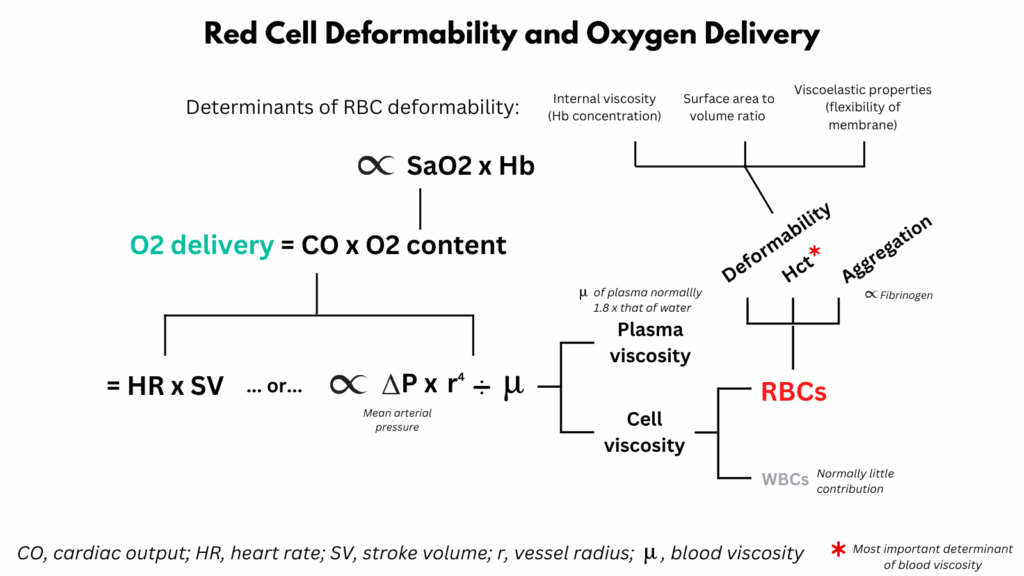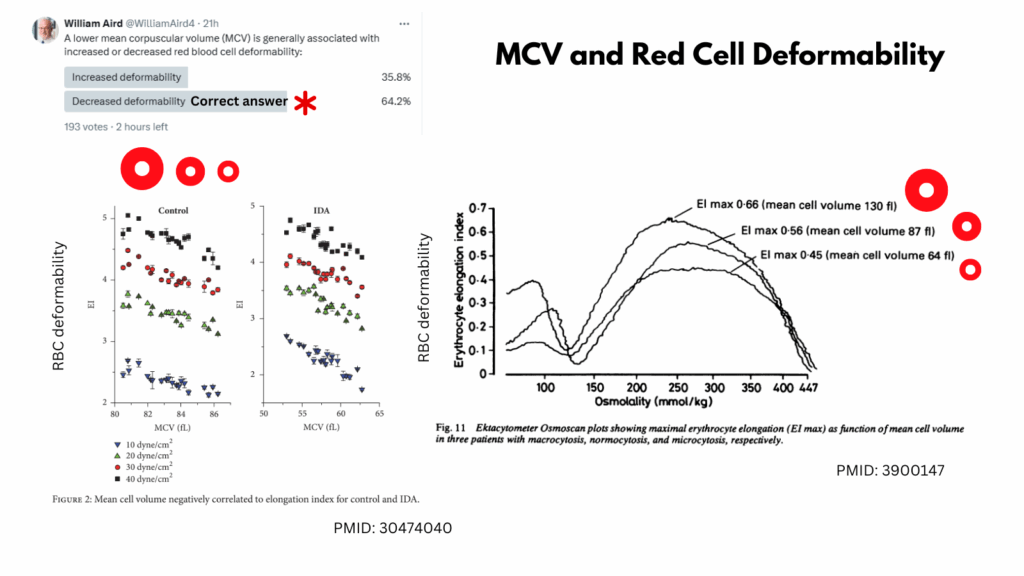
For larger image, click here.
What Is RBC Deformability?
RBC deformability is the ability of erythrocytes to change shape without rupturing as they pass through narrow capillaries (often smaller than their resting diameter of ~7–8 µm). A typical capillary may be just 3–5 µm wide, so flexibility is essential.
Why It Matters: Physiological Impact
- RBC deformability is a key biophysical property essential for:
- Smooth flow through microvasculature: Enables RBCs to traverse the smallest blood vessels.
- Optimizing blood flow and tissue perfusion: Since microcirculation governs oxygen delivery at the cellular level.
- Minimizing blood viscosity: Rigid cells increase flow resistance, worsening microcirculatory and macrovascular hemodynamics.
| Parameter | Effect of ↓ Deformability | Mechanism |
|---|---|---|
| Blood viscosity | ↑ Viscosity | Rigid RBCs increase flow resistance, especially at low shear rates |
| Peripheral resistance | ↑ Resistance | Impaired flow through microvasculature raises systemic vascular resistance |
| Cardiac output | ↓ Cardiac efficiency / ↑ workload | Higher resistance requires more force to maintain perfusion |
| Oxygen delivery (DO₂) | ↓ Tissue oxygenation | Impaired capillary transit limits oxygen transfer |
Major Determinants of RBC Deformability
- Membrane Cytoskeleton:
- Spectrin, ankyrin, actin, and associated proteins form a lattice under the lipid bilayer.
- Mutations (e.g., hereditary spherocytosis, elliptocytosis) impair flexibility.
- Lipid Bilayer Composition:
- Alterations in cholesterol or phospholipids can stiffen the membrane.
- Seen in liver disease or abetalipoproteinemia.
- Cytoplasmic Viscosity:
- Controlled by hemoglobin concentration (MCHC).
- ↑ MCHC (e.g., in sickle cell disease, hereditary xerocytosis) → ↑ internal viscosity → ↓ deformability.
- Mean Corpuscular Volume (MCV):
- Smaller RBCs may have:
- Reduced surface area-to-volume ratio (less flexible)
- Increased internal viscosity (due to relatively high hemoglobin concentration → ↑ MCHC)
- Reduced deformability
- Smaller RBCs may have:
- ATP levels:
- ATP maintains membrane fluidity and regulates cytoskeletal interactions.
- ↓ ATP (e.g., in stored blood or metabolic disorders) impairs deformability.
- Oxidative Damage:
- Oxidation of membrane proteins or lipids stiffens RBCs.
- Seen in G6PD deficiency, diabetes, sepsis.

For larger image, click here.
Clinical Implications
- Diseases like sickle cell anemia and diabetes cause marked reduction in deformability, increasing viscosity and peripheral resistance, impairing oxygen delivery, and stressing the heart.
- Therapeutic approaches sometimes aim to improve deformability or mitigate consequences (e.g., hydration, oxygen therapy).
Summary
RBC deformability is essential for low-resistance flow, capillary transit, and oxygen delivery. It depends on the membrane structure, internal viscosity, and energy status of the cell. Loss of deformability increases viscosity, vascular resistance, cardiac workload, and impairs tissue perfusion.
